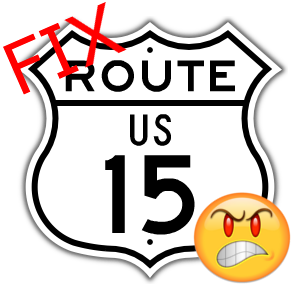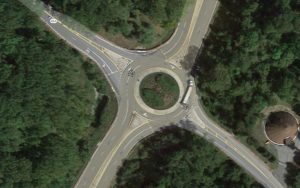Roundabouts are a hot topic when it comes to the discussion of Route 15 improvements. Some groups would have you believe that just installing a roundabout at White’s Ferry Road would solve all the problems of the Route 15 corridor. They will also put forward plans that would turn Route 15 from Leesburg to the Point of Rocks Bridge into a series of roundabouts while placing obstacles, trees, and other impediments in places that would force vehicles to slow down in order to navigate through the corridor and avoid running into something. This is also known as “traffic calming”. We will address these two items separately.
First, some background. We at fixroute15now.com are a data driven, fact-based group and we will acknowledge the road engineering science of why some roundabouts work at certain intersections. There are real-world benefits to well-constructed roundabouts in the right locations. The challenge faced by many looking for a non-biased view of where and when roundabouts work is that most, if not all, readily available sources are either 100% for or against roundabouts. The vast majority of studies are also based on lower capacity single lane roundabouts rather than the higher capacity, multi-lane examples.
We did manage to find Mr. Mike Spack, PT, PTOE. He is a traffic engineer with many years of experience and a supporter of roundabouts. You can read his bio here: http://www.mikeontraffic.com/about/. His website, mikeontraffic.com, is a great source for balanced information regarding the use of roundabouts. http://www.mikeontraffic.com/why-build-roundabouts/ explains in detail the approach to building as well as positives and negatives of roundabouts. He mentions (our emphasis highlighted):
“Research suggests a single lane roundabout can accommodate up to 25,000 vehicles per day. A multi-lane roundabout with two entry lanes can accommodate up to 45,000 vehicles per day. Like other traffic engineering tools, a roundabout works better with certain characteristics. The ideal conditions for a roundabout are:
- Balanced traffic flow between all four legs. An unbalanced intersection with 90 percent of the volume on the major street may not see the same benefits as other more balanced locations.
- High left turn movements. Left turns, and U-turns, are accommodated extremely well by a roundabout.
- High crash history. Roundabouts can help reduce the severity of crashes and sometimes the overall number of crashes.
- Complex geometry. A roundabout can often accommodate more than four legs and/or skewed intersections better than stop signs or a traffic signal.”
On this same page he also lists the major drawbacks of roundabouts:
“There are no silver bullets in transportation planning and engineering. Roundabouts are a better choice than traffic signals at most locations, however there are a few limitations the design engineer should consider:
- There may not be enough room to build the roundabout.
- A corridor with a heavy commuter pattern (most vehicles going one direction in the morning and then returning in the evening) can sometimes provide less delay with coordinated traffic signals.
- The overall distance pedestrians need to walk is often longer around a roundabout than a traffic signal controlled intersection.
- More difficult for visually-impaired pedestrians to cross compared to traffic signals.
- Roundabouts are static. Traffic signals can adapt to significantly different traffic patterns, like traffic letting out after a concert or football game at a stadium.
- Multi-lane roundabouts can be difficult in terms of design and operation. The delay and safety experience at a multi-lane roundabout is sensitive to small geometric characteristics.”
Ask yourself this question – does Route 15 have balanced flow from all sides or does it have a “heavy commuting pattern” with the vast majority of volume coming from one direction?
Now on to the numbers. According to VDOT’s 2017 volume numbers found here: http://www.virginiadot.org/info/2017_traffic_data_by_jurisdiction.asp, the traffic count on Route 15 around the Point of Rocks Bridge is 21,000 vehicles per day and 26,000 per day around White’s Ferry Road. Both are increasing every year. Mr. Spack provides the guidelines that a single lane roundabout can handle up to 25,000 vehicles. That is less than the current volume on Route 15 at White’s Ferry and will be less than the volume on the rest of the corridor by the time any project is completed. This means that large multi-lane roundabouts with a 45,000 vehicle capacity would be required at all intersections, if implemented.
Separate from roundabouts, He also mentions on another page: http://www.mikeontraffic.com/numbers-every-traffic-engineer-should-know/ the acceptable planning levels of daily capacity for several types of roads themselves. The two most pertinent ones are:
- 2 lane (w/ left turn lanes): 18,300 vehicles per day
- 4 lane (w/ left turn lanes): 36,800 vehicles per day
These numbers tell us that regardless of what type of intersections are installed between Leesburg and the Point of Rocks Bridge (i.e. traffic light or roundabout), expansion to 4 lanes is going to be required for the entire corridor in order to handle current volume.
We have also found this statistical analysis which draws the conclusion through regression analysis that the planning capacity of roundabouts is almost always overstated compared to actual results. https://www.sciencedirect.com/science/article/pii/S2095756416300563. One of the main challenges with roundabouts, and multi-lane roundabouts in particular is that driver behavior ultimately determines capacity and safety. One example of a problem situation lies just a few miles north of us.
The Google Maps satellite shows the roundabout on Route 15 in Maryland near the Point of Rocks Bridge. This is a multi-lane roundabout that the special interest groups love to point to as a success story. This roundabout has approximately 21,000 vehicle trips per day. Notice the semi-truck having to cross into the other lane in order to make the turn. Is this safe?
So, with all of this data in mind, what we have here is an idea proposed by the special interest groups – turn the Route 15 corridor into a series of roundabouts – that, at best:
- still requires 4 lanes to handle the volume;
- will not work based on the pattern of heavy north/south volume;
- functions LESS efficiently than coordinated traffic lights; and
- creates potential safety issues when semi-trucks and other large vehicles must cross multiple lanes at once in order to navigate through the roundabout.
The special interest groups also maintain, despite the volume numbers proving otherwise, that single lane roundabouts AND traffic calming measures throughout the corridor will keep traffic moving. This is simply a false narrative and they need to be called out on it.
Please visit us again tomorrow when we will explain how the Route 50 roundabouts and traffic calming measures around Gilbert’s Corner and westward are not representative of the situation on Route 15.
Fix Route 15 Now!

